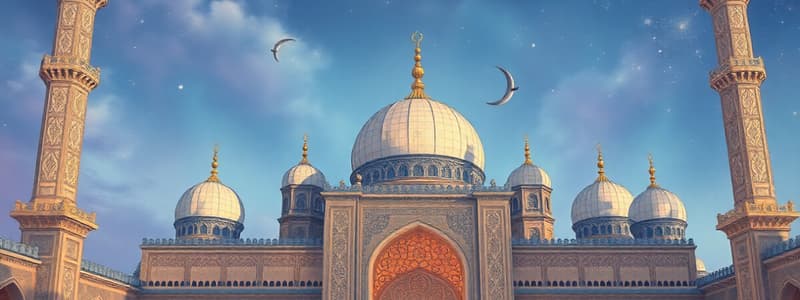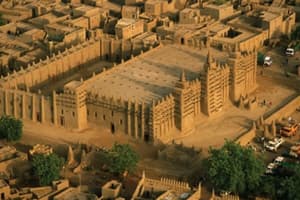Podcast
Questions and Answers
Between what years did the Abbasid era, specifically the first Abbasid era, take place according to the Islamic calendar (Hijri)?
Between what years did the Abbasid era, specifically the first Abbasid era, take place according to the Islamic calendar (Hijri)?
132-447 AH
Describe the geographical reach of the Arab Empire at its peak, as indicated in the provided map.
Describe the geographical reach of the Arab Empire at its peak, as indicated in the provided map.
The Arab Empire extended across North Africa, Spain, parts of Europe including Rome, and eastward through the Middle East into parts of India.
What are the approximate Gregorian calendar years that correspond to the period of the first Abbasid era?
What are the approximate Gregorian calendar years that correspond to the period of the first Abbasid era?
750-1055 AD
Name three major cities that were part of the Arab Empire, as indicated on the map.
Name three major cities that were part of the Arab Empire, as indicated on the map.
In which modern-day country is the Great Mosque of Kairouan located?
In which modern-day country is the Great Mosque of Kairouan located?
What is the estimated total area of the Great Mosque of Kairouan in square meters?
What is the estimated total area of the Great Mosque of Kairouan in square meters?
What specific architectural element is located above the mihrab in the Great Mosque of Kairouan?
What specific architectural element is located above the mihrab in the Great Mosque of Kairouan?
Besides religious functions, what other roles might the Great Mosque of Kairouan have served, considering its large area and facilities?
Besides religious functions, what other roles might the Great Mosque of Kairouan have served, considering its large area and facilities?
Identify one architectural element of the Great Mosque of Kairouan and describe its function or significance.
Identify one architectural element of the Great Mosque of Kairouan and describe its function or significance.
What are the approximate dimensions (in meters) of the Great Mosque of Kairouan's sahn (courtyard)?
What are the approximate dimensions (in meters) of the Great Mosque of Kairouan's sahn (courtyard)?
What is the height of the minaret at the Great Mosque of Kairouan?
What is the height of the minaret at the Great Mosque of Kairouan?
The construction of the Great Mosque of Kairouan in Tunisia started in 221 AH (836 AD) and was later rebuilt. What does this suggest about the historical development and structural integrity of the mosque?
The construction of the Great Mosque of Kairouan in Tunisia started in 221 AH (836 AD) and was later rebuilt. What does this suggest about the historical development and structural integrity of the mosque?
Identify two structural elements that define the perimeter of the Great Mosque of Kairouan.
Identify two structural elements that define the perimeter of the Great Mosque of Kairouan.
What purpose does the 'باب للا ريحانة' (Bab Lalla Rihana) serve in the Great Mosque of Kairouan?
What purpose does the 'باب للا ريحانة' (Bab Lalla Rihana) serve in the Great Mosque of Kairouan?
Based on the ground plan of the Great Mosque of Kairouan, describe the spatial relationship between the sahn (courtyard) and the prayer hall.
Based on the ground plan of the Great Mosque of Kairouan, describe the spatial relationship between the sahn (courtyard) and the prayer hall.
The lecture is titled 'Intro to Islamic Architecture' and the example provided is the Great Mosque of Kairouan. What are some key components that are commonly found in Islamic architecture?
The lecture is titled 'Intro to Islamic Architecture' and the example provided is the Great Mosque of Kairouan. What are some key components that are commonly found in Islamic architecture?
From the information given of the Great Mosque of Kairouan, what would you describe is the orientation of the mosque and why is it important?
From the information given of the Great Mosque of Kairouan, what would you describe is the orientation of the mosque and why is it important?
How might the climate in Tunisia have influenced the architectural design of the Great Mosque of Kairouan?
How might the climate in Tunisia have influenced the architectural design of the Great Mosque of Kairouan?
Explain the significance of Islamic architecture's geometric shapes.
Explain the significance of Islamic architecture's geometric shapes.
What is the Qibla wall?
What is the Qibla wall?
Flashcards
The Early Abbasid Period
The Early Abbasid Period
The period of Islamic architecture during the early Abbasid Caliphate.
Greatest Extent of the Arab Empire
Greatest Extent of the Arab Empire
The geographical extent of the Arab Empire between 700-850 AD
The Great Mosque of Kairouan
The Great Mosque of Kairouan
A mosque that is located in Tunisia and was built in 221 AH (836 AD).
Middle Balata (البلاطة الوسطى)
Middle Balata (البلاطة الوسطى)
Signup and view all the flashcards
Qibla Wall (جدار القبلة)
Qibla Wall (جدار القبلة)
Signup and view all the flashcards
Mihrab location (موقع المحراب)
Mihrab location (موقع المحراب)
Signup and view all the flashcards
Dome over Mihrab (القبة فوق المحراب)
Dome over Mihrab (القبة فوق المحراب)
Signup and view all the flashcards
Minaret (المئذنة)
Minaret (المئذنة)
Signup and view all the flashcards
Outer Wall (السور الخارجي للجامع)
Outer Wall (السور الخارجي للجامع)
Signup and view all the flashcards
Courtyard (الصحن)
Courtyard (الصحن)
Signup and view all the flashcards
Study Notes
- This lecture introduces Islamic Architecture.
- It focuses on architecture during the Early Abbasid Era (132-447 AH / 750-1055 AD).
- The Arab Empire reached its greatest extent between 700-850 AD.
- The Great Mosque of Kairouan is used as an example for the lecture.
- The Great Mosque of Kairouan is located in Tunisia.
- The mosque was built in 221 AH / 836AD.
- It was rebuilt later.
Great Mosque of Kairouan Features
- The total area of the mosque is 9000 square meters.
- The minaret is 31.50 meters high.
- The outer wall of the mosque is 72.70 meters long.
- The prayer hall measures 125.20 meters.
- The qibla wall faces Mecca.
- The dome is above the mihrab.
- The hall of prayer is also known as the prayer house.
- The minaret's gate is next to the minaret itself.
- There is a courtyard.
- There is a southern portico.
- There is a median plate.
Studying That Suits You
Use AI to generate personalized quizzes and flashcards to suit your learning preferences.




